
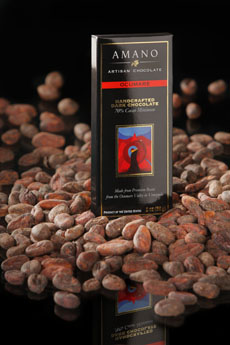
All chocolate comes from cacao beans. Photo courtesy of Amano Chocolate, a NIBBLE Top Pick Of The Week.
March 2005
Last Updated April 2025
|
|
Chocolate Glossary
Terms & Definitions: Belgian Chocolate & Other Terms With “B”
On this page, you’ll find terms like Baker’s chocolate, Belgian chocolate, and bloom. If you think we should consider chocolate terms and definitions other than those we have provided, or you’d like to suggest additional words for inclusion, click on the Contact Us link on this page. Also, enjoy our many other food glossaries.
Click on a letter to go to the appropriate glossary page.
a b c d e f g h i j k l m n o p q r s t u v w x y z
This glossary is protected by copyright and cannot be reproduced in whole or part.
BAKER’S CHOCOLATE or BAKING CHOCOLATE or BITTER CHOCOLATE or UNSWEETENED CHOCOLATE
A solid, bitter chocolate made from pure chocolate liquor, i.e., the cacao content is 100% with no sugar added. Historically, its only purpose was for baking. While it sounds like a generic term for chocolate used by bakers, the best-known brand is named for Dr. James Baker, a physician and owner, with John Hannan, of the first American chocolate mill. Baker’s Chocolate is now a trademark of Kraft Foods. There are other brands of baking chocolate, and today, the finest chocolate manufacturers are producing an unsweetened product, called 100% cacao content chocolate, that can be eaten as well. Some people who favor bittersweet chocolate enjoy the pureness of fine chocolate made with no sugar, as do diabetics who cannot have sugar. See also brut. |
|
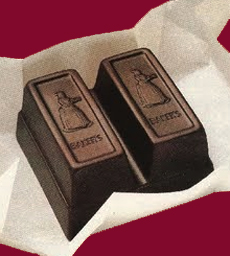
Baker’s Chocolate is named after chocolate manufacturer James Baker. |
NOTE: Greater Boston was the site of the first U.S. chocolate factories: in 1765 an Irish chocolate maker, John Hannan, put up a mill on the site of an old powder mill in Milton and imported cocoa beans from the West Indies to produce cakes of ground cacao bean paste used to make drinking chocolate. Other ventures sprouted up in the area. In 1780, Harvard graduate, teacher, and medical student James Baker saw the possibilities of the chocolate business and went into it with great success, producing the now-famous BAKER’S brand of chocolate. For the complete story, visit the Dorchester Atheneum. The brand is now owned by Kraft.
BAIN-MARIE
A bain-marie, or “Mary’s bath,” is the French equivalent of a double boiler. It melts chocolate gently over warm water so the chocolate will not burn. The “bath” refers to the method of placing a pan of food in another pan with simmering water. The term was originally used in alchemy and was named after Moses’s sister, who was an alchemist.
BALLOTIN
A ballotin is a box developed in Belgium with structured compartments designed to prevent the chocolates from crushing each other. Unlike boxes that hold chocolate in ridged paper cups, chocolates in ballotins cannot move from their designated compartments. Ballotins are of elegant design, befitting its contents. The ballotin was invented in 1912 by Louise Agostini, whose husband was a grandson of the founder of Neuhaus Chocolates.
BARREL-AGED CHOCOLATE
As it does with wines and spirits, barrel-aging imparts a compiled array of flavors into coffee, cocktails, hot sauce, and other foods. Barrel aging can mellow the chocolate flavor while adding a hint of the spirit the barrel previously contained. Small artisan chocolatiers are creating bars from beans that are aged in wood barrels, where they pick up the natural notes of the wood barrel (like vanilla and oak) and hints of the bourbon, rum, or other spirit or ingredient that was previously stored in the cask. The flavor profile of barrel-aged chocolate is generally subtle, but some chocolatiers also soak the cacao beans with spirits while simultaneously aging them in the barrel. To’ak Chocolate in Quito, Ecuador, was a pioneer in creating barrel-aged chocolate. Beginning in 2013, the company has aged its beans in 15 varieties of barrels, specialty casks, and Ecuadorian wood for as long as four to five years [ source]. |
|
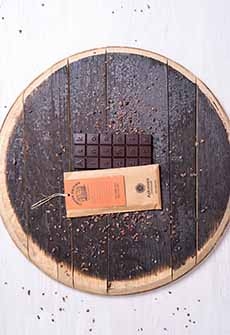
A barrel-aged chocolate bar from Askinosie Chocolate. |
BÂTON
A French term for a slim bar of chocolate, a specialty size differentiated from a regular eating bar, which is called a tablette.
BEAN
Also called the grain, the seed of the cacao pod of the Theobroma cacao tree, beans are the source of all chocolate and cocoa. There are generally 20 to 40 flat, almond-shaped beans in a pod, depending on the species. When first picked, the beans have tropical flavors of lychee and pineapple, but in a few hours, the sugars convert, and they become bitter and inedible. Beans are then fermented, dried, roasted, ground, and conched to create chocolate. All cacao is grown in tropical rainforests; almost all of these are in third-world countries. Producers of chocolate purchase the beans through brokers who are on the ground in the countries of origin. Some cacao beans are purchased directly from small cooperatives of growers, others from individual farms, and in some countries, such as Ghana, the beans must be bought through a country's Cacao Board.
BEAN TO BAR
This term refers to a chocolate maker who makes chocolate from scratch, starting with the selection of raw cacao beans. The beans are then roasted and turned into couverture, the large blocks of chocolate that are then melted and used to make chocolate products—bars, bonbons, etc. Here is the chocolate production process. The alternative is to purchase ready-made couverture chocolate.
BELGIAN or BELGIAN-STYLE CHOCOLATE
Of the three styles of bonbons—Belgian, French, and Swiss—Belgian chocolates are characterized by a slightly larger size, a thicker chocolate shell, and a heavier and sweeter ganache. Belgian chocolates are made in molds, accounting for the thicker shell. The technique of molding was created by Belgian chocolatier Jean Neuhaus in 1912. who developed a process to pour couverture into molds, creating a hard shell, enabling softer, more liquid fillings like cremes to be used. Prior to then, firm centers like caramels, jellies, and thick ganaches were hand-dipped into the couverture. Some Belgian chocolatiers also use cookie pieces when creating certain chocolates. (Pierre Marcolini, who is also a patissier, does some wonderful pieces with cookies; although Marcolini, a Belgian, actually makes French-style chocolates).
BITTER CHOCOLATE
Another word for Baker’s chocolate or unsweetened chocolate.
BITTERSWEET CHOCOLATE
|
Sweetened dark chocolate contains at least 35% chocolate liquor, in addition to sugar and cocoa butter. The darkest chocolate with the most intense cacao flavor, bittersweet can also be used for baking. When expressed as a percentage of cacao in a bar, bittersweet chocolates have 70% or more. The common percentages of bars are 70%, 73%, 85%, 99%, and 100%. Percentages are based on the manufacturer’s preference and formula or “recipe.”
BLACK COCOA POWDER
Black cocoa powder is Dutched cocoa powder that has been heavily alkalized. It is more black than brown in color (think Oreos) and has a smoother taste with no bitterness. But it also tastes much less chocolatey.
The shade was invented because black food color tends to stain. Some bright person realized that the a black-brown color could be achieved by treating natural cocoa with a stronger alkaline solution than is used for standard Dutched cocoa. But the color comes at the cost of less acidity and less chocolate flavor. Also see red or rouge chocolate.
|
|
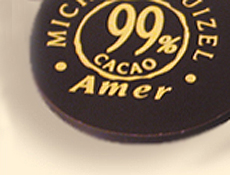
This tasting disk from Michel
Cluizel is 99% cacao—almost
pure chocolate, with only 1% sugar.
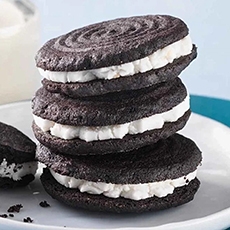
Black cocoa provides the color (photo © King Arthur Baking). |
BLENDED BAR
A chocolate bar made of beans with any combination of bean varieties, growing regions, and harvest years. The opposite of a blended bar is a single-origin bar, where all of the beans come from the same area, or a grand cru bar, where all of the beans come from the same plantation or estate. Blended bars are sometimes called “house bars” because they are blended into a consistent recipe year after year to represent the house style of the producer.
BLENDING
The process that takes place with chocolate that is not a single bean, e.g., 100% Porcelana—i.e., most chocolate. After roasting and before grinding, the crushed cacao beans are blended in a formula or “recipe” determined by the master blender to determine the flavor of the finished chocolate. Since even beans from the same region can vary in flavor from harvest to harvest—acidic, fruity, earthy, sweet, bitter, spicy, woody, etc.—the blending process, along with the flavoring process, produces a consistent “house style.”
BLONDE CHOCOLATE, A.K.A. GOLD CHOCOLATE & DULCEY CHOCOLATE
Blonde chocolate was a happy accident. The famous French pastry chef Frédéric
Bau was in Japan for a chocolate trade fair. He let his white chocolate melt in a bain-marie a bit too long, which gave it a beautiful blonde hue and flavor and aroma notes of toasted shortbread and caramelized milk.
Frédéric Bau had discovered a fourth color for chocolate. It took Valrhona eight years of research and development to develop the final Blond Dulcey recipe, officially releasing it in 2012 as the first “blonde chocolate.”
The name Dulcey comes from Frédéric Bau, who named it after the French word “dulce,” meaning sweet or sugary.
His creation made blonde/dulce/gold chocolate the fourth variety, after dark, milk, and white chocolates. The fifth variety available today, ruby/rose chocolate, was introduced in 2017 by Barry Callebaut. It was developed from a special variety of ruby cocoa beans and has a natural pink color with a fruity, berry-like flavor. |
|

Above: Feves of dulcey chocolate, to be made into chocolate bars and bonbons (photo © Valrhona Chocolate). Below, blonde chocolate bars (photo © NuChocolate).
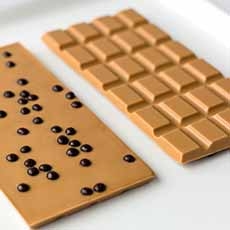 |
BLOOM
There are two kinds of bloom that form on the surface of chocolate: Both are temperature-related, and both make the chocolate look suspect and unappetizing. With fat bloom or cocoa butter bloom, the chocolate loses its gloss: A powdery grayish-white or tan film forms on the surface. This is due to improper storage, poor tempering, lack of tempering, or changes in temperature. Heating chocolate above 70°F, as well as repetitive heating and cooling, will cause microscopic cocoa butter particles to join together, leaving particles of sugar and cocoa uncoated. The bloom is the cocoa butter that has separated and risen to the surface. In some cases, the chocolate may become soft or crumbly. While bloom diminishes the appearance of the chocolate, it does not alter the taste and is not harmful. Chocolate with fat bloom can be eaten, although it may taste drier. Fat bloom can be avoided by storing chocolate at a constant temperature. Sugar bloom is caused by condensation due to excessive moisture. The moisture combines with the sugar in the chocolate to create a syrup. Large sugar crystals remain on the surface of the chocolate when the moisture evaporates. See Sugar Bloom for more information.
BONBON or BON BON
French for “good, good,” a hard shell of chocolate filled with a variety of centers. The full French term is bonbon de chocolat (or chocolats fourrés assortis for assorted filled chocolates). It is referred to as praline in Belgium, while in France, a praline is a caramelized almond. To add to the confusion, the word truffle, which refers to balls of ganache rolled in cocoa powder or other coatings, is used by some to describe hard shells filled with ganache. Unfortunately, there is no governing body to standardize terminology, so consumers need to read the fine print to understand what they are buying. See the larger discussions under praline and truffle.
|
|
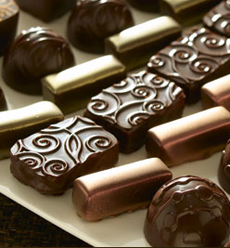
Assorted bonbons from
Antoine Amrani, a Top Pick Of The Week.
|
BOUCHON
A bouchon (BOO-shone), French for cork, is a molded, cork-shaped chocolate. It can be solid or filled.
BOUTIQUE CHOCOLATIER
Often, the term “boutique chocolatier” is substituted for artisan chocolatier, but they are different. While an artisan sells his/her handmade wares in a small shop or boutique, anyone with no skills can open a shop or “boutique” that sells chocolate purchased from elsewhere, that is not necessarily handmade or artisan quality. (In fact, companies like Hershey’s have chocolate boutiques—shops that sell only their products.)
BRUT or BAKER’S CHOCOLATE
An FDA classification of chocolate that does not contain any sugar, though it may contain flavoring like vanilla. This pure chocolate was initially intended for cooking, but today, fine 100% cacao chocolate is enjoyed by many. See baker’s chocolate.
BUTTERFAT or BUTTER FAT or MILKFAT
The natural fat in milk from which butter is made is separable from the milk by churning. There is no butterfat in cocoa butter, which is a vegetable product. The French word for butterfat is graisse butyrique.
BUTTER OIL
Clarified butter is used instead of more expensive cocoa butter in some chocolate formulations to create a smoother texture and mouthfeel.
Continue To The Next Page: Chocolate Terms With C
Go To The Article Index Above
Lifestyle Direct, Inc. All rights reserved. Images are the copyright of their respective owners.

|

![]()








